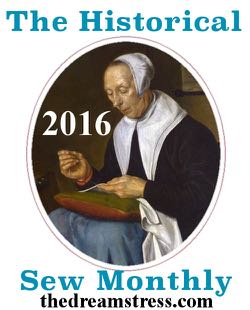HSM 2017: Challenge 4 - Circles, Squares & RectanglesApril Challenge 4 - Circles, Squares & Rectangles: make something entirely from above mentioned geometric shapes without using curves or triangles. People in early history tended to use fabrics in its natural form of longer or shorter rectangles. Good examples of this style are wraped, pleated and pinned garments of antient Egyptians, Greeks, Romans, Celts and other tribes. Statue Tiye, wife of Egyptian pharoah Amenhotep III and column featuring Antient Greece women in chiton. 

Metropolitan Museum of Art and Wikipedia During following epochas clothing patterns grew more complicated but rectangular pieces were still widely used on some of skirts, aprons, shirts, kerchiefs, shawls, cloaks, veils and even hood could be executed from two squares and one rectange. Hood based on archeological find in Skjoldehamn, Norway, 11th century. 
Norse Wiki Circle or half circle shaped clothing are much rare to find, but did occure - most in form of cloaks, headdress and 16th - 17th century petticoats and. Catherina Parr wearing half circle petticoat over fartingale, 1545. 
National portrait Gallery, Wikipedia Fabrics were usually too narrow for cutting f.e. longer cloaks, so material was pieced as shown in Alcega´s taylor´s masterpiece book: 
Biblioteca Digital Hispanica If you consider clothing made from rectangles and circles it too easy and not challenging at all, you coul always focus on material and decoratiuons: Fabric woven on hand loom with plaid pattern could be used for plain rectangular skirt. Replica of clothing found in bog grave in Huldermose, Denmark, 200BC, but accorging research, fabric now brown was formely blue. 
National Museum of Denmark Simple dress could be decorated with tablet weaved band from natural dyed yarn. Reconstruction of dress foun in Lonne Hede, 1st - 2nd century AD. 
Sagnlandet Lejre One of the mocst basic type of decoration is embroidery. Crewelwok on mid 18th century petticoat. 
Museum of Fine Arts Boston Black crewelwork on 17th century work bag. 
Cora Ginsburg, Costume, Textiles & Needlework
Whitework and lace handkerchief, 1825 - 1850.

Metropolitan Museum of Art During 16th and 17th century collars were made of laces (or at least decorated with laces). These could be circle, square or gathered reclangle stape. Follower of Robert Peake the Elder, Portrait of a Lady in a lace collar. 
Bonhams Another elegant embellishing could be done by quilting. Silk petticoat, mid-18th century. 
Museum of Fine Arts Bostont Sometimes even plain shirt could entertain seamstress while making fine stroke garters and buttons. Linen shirt, 1700 - 1720. 
Victoria&Albert Museum Beside garters it is possible to use smocking for shaping dress too. In Luttrell Psalter there is a women wearing smocked apron (on left) and other having purse with tassels (on right). 
British Library Another use of tassels together with fur we can see on evening muff, 1875 - 1900. 
Metropolitan Museum of Art Fringes could be also tied as shown on this painted plaid, 1840´s. 
Metropolitan Museum of Art Although fashion was developin more and more elaborated patterns and cuts, there is exception - during 20´s cubism and art deco brought popularity of pure geometric shapes. During this decade a lot of slips, skirts, dresses and coats were draped from rectangles. Blog Midvale Cottage Post features endless examples of period tips for home sewing and adaptation of clothing, (even less complicated than patterns for period tailors). All following samples are from abovementioned blog. 
 
 
Midvale Cottage Post blog |


english / česky write me at klara.parolkova )( seznam.cz |
